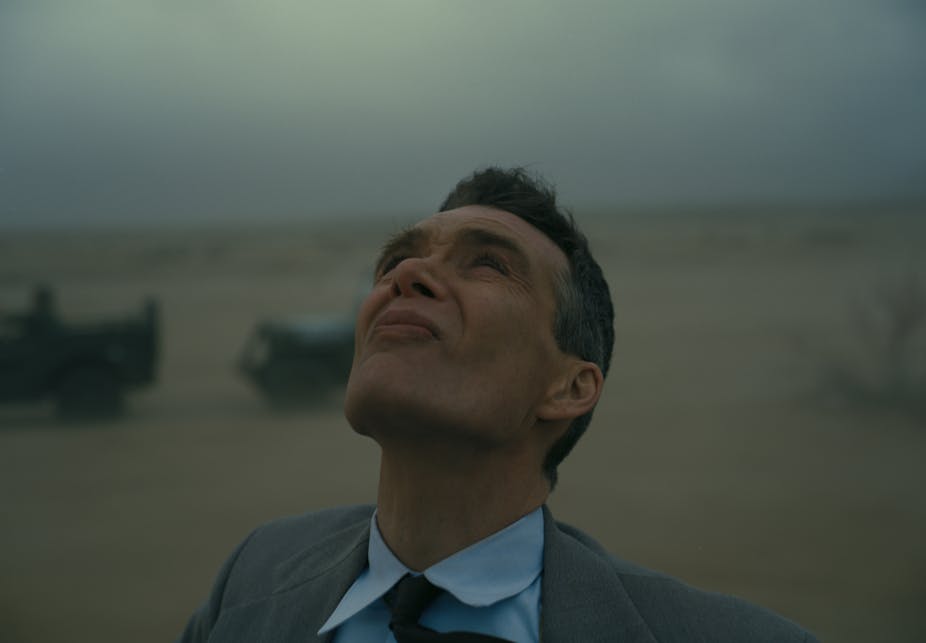One of this summer’s biggest cinematic events, Oppenheimer, brings the story of US scientist J. Robert Oppenheimer to the big screen. Director Christopher Nolan’s film is the latest of many portrayals of the so-called “father of the atomic bomb” on page, stage and screen. Here are six of the most intriguing.
1. The Man Who Would Be God by Haakon Chevalier (1959)
This novel is particularly fascinating in that it was written by a friend of Oppenheimer, who played a role in his downfall. In winter 1942-43, Chevalier sounded out Oppenheimer’s stance on passing secrets to the Soviet Union.
Oppenheimer’s delay in reporting this conversation to US security services and inconsistencies in his testimony about it, were key – along with his opposition to the hydrogen bomb – to the 1954 hearing that saw his security clearance revoked. Chevalier’s life changed too. In the McCarthyite atmosphere of the early 1950s, he could no longer work at US universities.
The novel tells the story of a young security agent, Mark Ampter, sent to infiltrate the circle of Sebastian Bloch (a thinly disguised version of Oppenheimer). Seduced by Bloch’s charisma, Ampter is drawn toward the political causes Bloch advocates. Chevalier presents Bloch as intoxicated by the force of his own personality and power over others. An agent’s report notes that “a kind of invisible light … radiates from his presence”, as if he takes on the troubling qualities of the radioactive materials with which he works.
2. Oppenheimer (BBC, 1980)
The BBC’s BAFTA-winning drama series is also interested in how Oppenheimer’s involvement in left-wing 1930s politics shaped his fall from grace after the second world war.
Opening credits show a secret tape playing Oppenheimer’s conversations (the FBI file on Oppenheimer, opened in 1941, eventually ran to 7,000 pages) and the series builds to the fateful security hearing.
Sam Waterston’s nuanced performance portrays Oppenheimer as a brilliant but troubled figure. The drama explores many dimensions of Oppenheimer’s story including his recruitment by General Groves (who led the Manhattan Project that produced the first atomic bombs), his relationships with his lover, Jean Tatlock and wife Kitty, the building and testing of the atomic bomb and the scientists’ reaction to the devastating use of their invention at Hiroshima and Nagasaki, where up to 250,000 people died.
3. Doctor Atomic by John Adams (2005)
Set in the month before the Trinity Test of the first atomic bomb (an event depicted in many creative works), Adams’s opera focuses on Oppenheimer at a moment of maximum stress.
Frequently, depictions of Oppenheimer draw on mythic archetypes, presenting him as a Promethean or Faustian figure. But the tortured figure Adams presents is very human. In one aria, the words of the poet John Donne (“Batter my heart, three-person’d God”) show an Oppenheimer who is profoundly shaken by the terrible potential of his invention.
4. Oppenheimer by Tom Morton-Smith (2015)
Another stage production, Morton-Smith’s play was put on by the Royal Shakespeare Company. The number of such adaptations shows how tempting it is to view Oppenheimer’s story in ways echoing Shakespearean or classical tragedy, in which someone of high standing, brought low by a fatal flaw, changes society.
The play draws out Oppenheimer’s complexity, also impressively sketching in contexts of atomic physics and his 1930s political activism. It keeps in view the terrible suffering produced by the atomic bomb, as in a scene where Oppenheimer’s colleague, Robert Serber, recounts his experience as one of the American team who entered Hiroshima and Nagasaki in September 1945 to assess the damage of the atomic bombs.

5. Quartet for J. Robert Oppenheimer by Kelly Cherry (2017)
Cherry’s impressive 121-poem biography of Oppenheimer harnesses the allusive potential of poetry to produce an intriguing, multifaceted depiction of his life.
Expanding beyond the remit of most depictions, which focus on the years between the 1930s and 1950s, Cherry’s collection follows Oppenheimer from birth to death. She moves between intimate personal details (Smoking in Bed), historical context (Kristallnacht) and the atomic bomb (August 6, 1945).
6. Trinity by Louisa Hall (2018)
Hall’s recent novel takes the interesting and effective decision to displace the portrayal of Oppenheimer into the stories of seven fictional narrators whose lives he briefly touches.
These include a secret service agent trailing him as he visits former lover Jean Tatlock in San Francisco, a secretary during the 1954 security hearing and a reporter who interviews him just before he dies. Oppenheimer is depicted as an elusive figure, constantly sliding away from attempts to pin him down.
When one narrator hears his famous claim to have thought of the words of the Hindu scripture Bhagavad Gita at the moment of the Trinity Test, she claims that “for Robert, there was no language short of myth to describe his bad situation.” She could be reflecting on the tendency, in many narratives about Oppenheimer and the birth of the nuclear age, to reach for mythic imagery.
That writers, directors and composers keep retelling his story shows how enigmatic and elusive Oppenheimer is. These tales are ways of exploring the profound implications of living in a nuclear age.

Looking for something good? Cut through the noise with a carefully curated selection of the latest releases, live events and exhibitions, straight to your inbox every fortnight, on Fridays. Sign up here.

